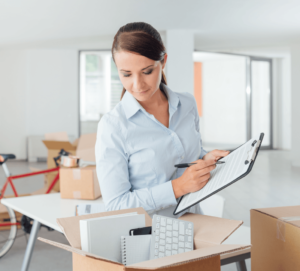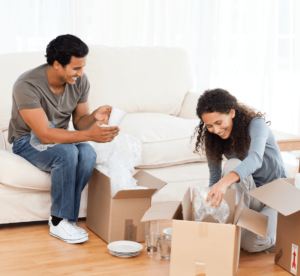
Moving is stressful enough; there’s no need to add to the chaos with last-minute packing or a disorganized approach. To ensure an easy move to your new home, good packing is crucial. Getting organized and starting to pack as early as possible can make your move a breeze – or as easy as moving can be.
Here’s a complete checklist to take control of your packing so you can do something even better: look forward to setting up and decorating your new home. 
Supplies
Without the right supplies, packing a home can be a nightmare. Don’t make the mistake of using second-hand boxes or skipping the “unnecessary” labelling supplies. You’ll end up regretting it when packing and loading takes longer and you can’t find anything once you’ve moved in. Here are the supplies you should have on hand before you get started.
- Boxes in various sizes. Always use new boxes because they’re sturdy, clean, and come in uniform sizes for easy stacking. It’s also important to get a range of sizes. Heavy items like books should be packed in the smallest boxes. You can use large boxes for pillows, linens, and other lightweight items.
- Box cutter. You’ll need this to unfold new boxes and open boxes that are taped shut.
- Toolkit. Basic tools will be necessary to disassemble furniture for moving.
- Large trash bags. This will make it easy to toss wrappers and trash as you pack.
- Sealable plastic bags. You can use sealable lunch bags for keeping small items like screws together.
- Packing paper. Use blank newsprint for wrapping fragile belongings or filling empty space in boxes.
- Bubble wrap. Large rolls of bubble wrap are handy for padding the bottom of boxes with fragile items and wrapping items that may break.
- Stretch wrap. You can use this to secure drawers and doors on furniture or bundle items together.
- Furniture blankets. These are used to protect furniture and mirrors.
- Felt pads. Use these to protect the floors while moving furniture.
- Coloured stickers. You can use these to colour-code boxes by room.
- Permanent markers. Use these to label your boxes.
- Pen and notebook. You’ll use this to keep track of the inventory of your boxes.
- Packing tape.
- Scissors.
- Labels.
Organization
 A haphazard packing strategy will backfire when it’s time to unpack and you don’t know where anything is or where the boxes go. Staying on top of organization as you pack will save you many hours of frustration later.
A haphazard packing strategy will backfire when it’s time to unpack and you don’t know where anything is or where the boxes go. Staying on top of organization as you pack will save you many hours of frustration later.
- Don’t pack it if you don’t want it. Purge anything unnecessary and unused to reduce the number of belongings you need to pack. As you sort through every drawer and corner of your home, place unwanted items into a large “sell” or “donate” box.
- Label every box with the destination and contents. Don’t assume you’ll remember which box goes where based on your description of the contents.
- Do not be vague. The more specific your content descriptions, the easier it will be to find what you’re looking for when you unpack. If you’re worried about detailed labelling on your boxes, number the boxes and keep the inventory with you.
- Don’t mix rooms in the same box. You’ll thank yourself when you’re unpacking.
- Use a number system. As you pack boxes, keep a labelled inventory list. Every item or group of items should be on the list. This will make unpacking easier and help ensure you don’t overlook anything. When you need to find the shampoo, you’ll know exactly where it is instead of digging through every “Bathroom” box you have. You’ll also know exactly how many boxes you’re moving to track if anything goes missing.
- Colour-coding boxes by room can be helpful, especially to make sure the movers put boxes where they belong.
- Try an app. There are plenty of free and paid apps that make packing and organization easy. Sortly helps you organize belongings in folders and sub-folders to keep track of what’s in every box. You can even create and link QR labels for your boxes.
Packing Tips
There’s a right way and a wrong way to pack boxes. Unfortunately, many people learn this the hard way when they get to a new home and discover their favourite glassware broken at the bottom of a box. Here are some tips to ensure your belongings make it to your new home in one piece.
- Heavier items go on the bottom. While this may seem obvious, it can be easy to get carried away while you’re packing. Always think about what you’re putting into a box – and what’s below it. This same principle applies to the moving truck, if you’re loading it yourself. Heavy boxes should be packed toward the front of the truck and under lighter boxes.
- Don’t leave empty space. Fill any gaps in the boxes with packing paper, towels, or even clothing.
- Some items need special care. Certain items will need to be packed differently. A TV, for example, must be protected on all edges as well as the front and it should be transported upright. You can find packing boxes specifically for TVs.
- Start packing unnecessary, out-of-season, and decorative items weeks or months before you move.
- Pack dishes vertically and wrapped in packing paper with empty spaces filled with bubble wrap. This reduces the risk of breaking.
- Cover toiletry lids with plastic wrap to prevent leaks. Unscrew the caps, wrap plastic wrap over the top, and screw the lid back on.
- Safeguard valuables by keeping them with you or purposefully mislabelling the box.
- Silverware can be labelled as “misc kitchen pantry,” for example.
Travel Kit
Whether you’re driving the moving truck yourself or meeting the movers at your new home, don’t forget to plan for the day or days you will be separated from your belongings and the first couple of nights in your new home. Pack a suitcase or clear plastic bin with the following items.
of nights in your new home. Pack a suitcase or clear plastic bin with the following items.
- Toilet paper
- Towels and shampoo
- Hand soap
- Clothes for a few days
- Toiletries
- Sheets, blankets, and pillowcases
- Important documents such as passport and insurance papers
- Medication
- Pet supplies
- Personal box for each family member. Everyone can add the items they will want right away in the new home.
Remember that a little organization goes a long way when packing up a home so focus on getting everything planned and in order as soon as possible. To avoid forgetting anything as you pack, keep a notebook handy for notes and reminders. The sooner you begin packing, the less work and stress you’ll have as moving day approaches.
Once you’ve moved in, you’ll have a different tasklist; here’s what you should do in the first 60 days of moving into your new home!




